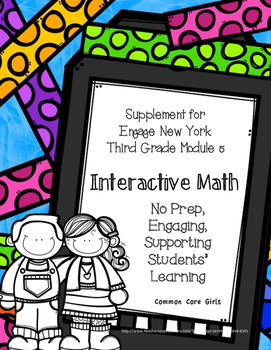Eureka/Engage NY 3rd Grade Guide Math Module 5: No Prep, Efficient Skill Builder
- PDF
Description
This is a no prep interactive math guide to supplement Third Grade Module 5 Eureka/Engage New York Curriculum. We created this interactive guide to focus students’ attention to vocabulary and concept development. At the top of each page is the module and lesson number with the student friendly objective. Also, the 1 page format is a great time saver allowing students to focus on the key ideas instead of cutting several pieces, pasting, coloring and copying definitions.
There is 1 page for each lesson that students cut and glue into a 10.5 x 8 inch spiral notebook (standard size) or complete without using a notebook. Students work on completing the page after the lesson is taught or this makes a great warm-up/review the following day. Teachers complete the guide with their students as a teacher lead activity or students can also complete this as an independent or partner activity. Then students/teacher share responses as a whole group for accuracy. Our students refer back to the pages when working on the problem set.
Answer keys are included to guide the teacher.
Included:
The module and lesson number
A student friendly objective
Vocabulary is reinforced through sentence frames allowing students to focus on key words for the definition.
Concept question
A place for students to provide examples for each vocabulary word and key concepts.





